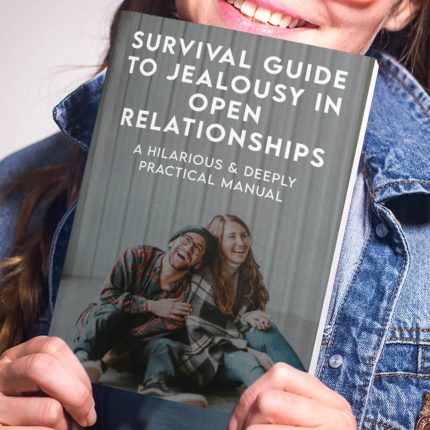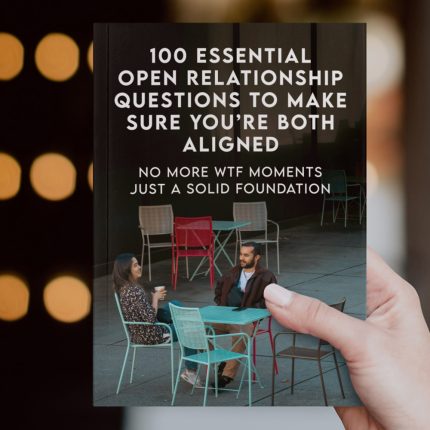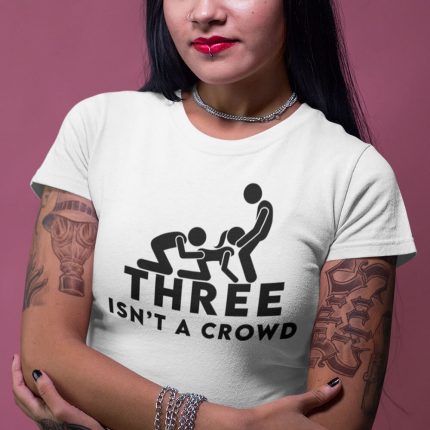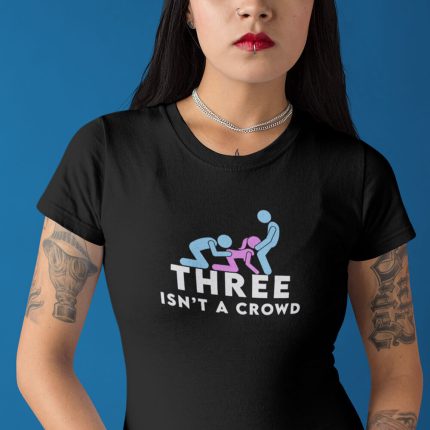Unified Non-Monogamy

Imagine a relationship model where every connection, every spark of intimacy, and every shared moment seamlessly weaves together into one unified tapestry—a holistic approach that dissolves the traditional boundaries between separate partnerships. Welcome to Unified Non-Monogamy, a transformative concept in ethical non monogamy that envisions love as a single, cohesive force rather than a collection of isolated bonds. In this framework, all relationships exist in an integrated system, where each connection not only stands on its own but also enriches and reinforces the entire network. Whether you’re nurturing deep romantic ties, sharing playful encounters, or blending emotional support across multiple connections, Unified Non-monogamy invites you to see your love life as one expansive, interconnected whole.
Have you ever wondered if monogamy is just a stupid little experiment? Open relationships, polyamory, relationship anarchy...find out which relationship dynamic suits you best with our one minute relationship test. See if you are just conforming to "societal norms". Reveal your truth >>
Quick Links to Useful Sections
- The Ethical Non Monogamy Term: Unified Non-Monogamy
- What Is Unified Non-Monogamy?
- Core Principles of Unified Non-Monogamy
- Historical and Cultural Perspectives on Unified Non-Monogamy
- From Isolated Bonds to Integrated Networks
- Cultural Shifts in Modern Relationship Models
- Everyday Dynamics of Unified Non-Monogamy
- Fostering Unified Communication
- Creating a Shared Vision and Collective Goals
- Balancing Individual Autonomy with Collective Unity
- Benefits of Embracing Unified Non-Monogamy
- Enhanced Trust and Emotional Security
- Personal Growth and Collective Empowerment
- Improved Communication and Conflict Resolution
- Collective Resilience and Shared Joy
- Challenges of Unified Non-Monogamy
- Managing Complex Group Dynamics
- Navigating External Judgment and Societal Norms
- Adapting to Continuous Change
- Frequently Asked Questions (FAQ)
- Resources and Community Support: Your Next Steps
The Ethical Non Monogamy Term: Unified Non-Monogamy
What Is Unified Non-Monogamy?
Unified Non-Monogamy is a relational model that emphasizes the integration of all your partnerships into a single, harmonious network. Rather than viewing each relationship as a separate entity with its own distinct boundaries and dynamics, this approach treats all connections as interrelated parts of a larger system. The idea is to create a sense of wholeness and shared purpose, where every partner’s role is recognized as a contributing piece to the overall structure of your intimate life.
In practice, Unified Non-Monogamy encourages you to foster communication and collaboration among all partners, ensuring that everyone is aligned with the same values, expectations, and goals. This model promotes the idea that love and connection are not finite resources, but rather expansive forces that can grow stronger when integrated into a unified whole. By breaking down the barriers that traditionally separate individual relationships, you create a network where emotional, physical, intellectual, and spiritual connections are interdependent, allowing each one to flourish while contributing to collective well-being.
Core Principles of Unified Non-Monogamy
- Holistic Integration: Every relationship is seen as an integral part of one larger, cohesive system. Each connection, regardless of its individual characteristics, contributes to and benefits from the overall network.
- Unified Communication: Open, transparent, and continuous dialogue among all partners is essential. This ensures that everyone is informed, involved, and able to contribute to shared decisions and the evolution of the relationship network.
- Mutual Empowerment: When love is unified, each partner’s growth uplifts the entire system. Mutual empowerment means that success and happiness are celebrated collectively, and challenges are tackled together.
- Adaptive Boundaries: While integration is the goal, maintaining clear and flexible boundaries is crucial. These boundaries evolve as the network grows, ensuring that individual needs are respected while contributing to the collective harmony.
- Shared Values and Vision: Unified Non-Monogamy relies on a common set of values and a shared vision for what the network should represent. This might include commitment to transparency, ethical behavior, and the continuous pursuit of personal and collective growth.
- Collective Responsibility: Every member of the network has a role in maintaining its integrity. This means taking responsibility for communication, conflict resolution, and the overall well-being of the group.
- Interdependence: Recognize that the strength of one relationship can positively influence the entire network. In a unified system, challenges faced by one partner are met with collective support, reinforcing the interconnected nature of all bonds.
Historical and Cultural Perspectives on Unified Non-Monogamy
From Isolated Bonds to Integrated Networks
For much of history, relationships have been defined by rigid, compartmentalized structures—often centered around exclusive, monogamous bonds. Traditional cultural narratives emphasized the idea of a singular, unbreakable partnership, leaving little room for multiple, interconnected relationships. However, as societal norms began to shift during the sexual revolution and subsequent progressive movements, people started to explore alternative forms of love that defied these narrow constraints.
EXPLORE OUR ETHICAL NON-MONOGAMY & OPEN RELATIONSHIP SHOP
👨💻👩💻 Digital Store (Instant Download)
🍆💦 Clothing Store (Worldwide Delivery Available)
Real Men Share Pop Art T-Shirt (White)
$29.99Multiple Lovers - Sharing Is Caring Unisex T-Shirt (Black)
$29.99I Love Watching Pop Art T-Shirt (Black)
$29.99Three Isn't a Crowd Unisex T-Shirt (White)
$29.99Real Men Share Pop Art T-Shirt (Black)
$29.99Three Isn't a Crowd Unisex T-Shirt (Black)
$29.99Sharing Is Caring Daddy Cap (Black)
$39.99It's Not Cheating If He Watches T-Shirt (Black)
$29.99I Love Watching Pop Art T-Shirt (White)
$29.99Sharing Is Caring Unisex T-Shirt (Black)
$29.99Fuck Each Other Not The Planet Unisex T-Shirt (White)
$29.99Fuck Each Other Not The Planet Unisex T-Shirt (Black)
$29.99Early advocates of ethical non monogamy challenged the notion that love must be divided into isolated compartments. They argued that when individuals form connections with multiple partners, these relationships do not have to exist in isolation; instead, they can be integrated into a unified network that provides collective support and enrichment. This evolution in thinking paved the way for models like Unified Non-Monogamy, which envision a harmonious system where every bond strengthens the others.
Cultural Shifts in Modern Relationship Models
In today’s global and digitally connected world, Unified Non-Monogamy resonates with individuals who seek authenticity, interconnectedness, and collective empowerment in their relationships. Millennials and Gen-Z are particularly drawn to models that break away from traditional exclusivity and instead promote a holistic, integrative approach to love. The rise of online communities, relationship blogs, and social media has further catalyzed the acceptance of interconnected relationship models.
Modern narratives emphasize that love is not a zero-sum game. Instead, when relationships are integrated, every connection can enhance the overall emotional well-being of each individual. Unified Non-Monogamy challenges you to rethink the limitations of traditional models and to embrace a love that is expansive, resilient, and capable of evolving with your personal growth.
Everyday Dynamics of Unified Non-Monogamy
Fostering Unified Communication
The cornerstone of Unified Non-Monogamy is open and consistent communication among all members of the network. In everyday practice, this means setting up regular group meetings, as well as individual check-ins, to discuss feelings, update boundaries, and share insights. The goal is to create a space where every partner feels heard, valued, and actively involved in the evolution of the collective.
- Group Discussions: Schedule regular meetings—either in person or virtually—where all partners come together to discuss the state of the relationship network, address any concerns, and celebrate collective achievements.
- Individual Check-Ins: Complement group meetings with one-on-one conversations to ensure that personal needs are not overlooked and that each partner has a dedicated space to express themselves.
- Shared Digital Platforms: Utilize online tools such as group chats, shared calendars, and collaborative documents to maintain ongoing dialogue and keep everyone informed about changes or updates in the network.
Creating a Shared Vision and Collective Goals
Unified Non-Monogamy thrives on a common set of values and a shared vision for what the network aims to achieve. Establishing collective goals helps to align all partners and ensures that every relationship contributes positively to the overall system.
- Vision Statements: Collaboratively create a vision statement or a set of guiding principles that encapsulate the values and goals of your relationship network.
- Shared Objectives: Set mutual objectives for collective growth, such as improved communication practices, regular social gatherings, or collaborative projects that benefit the entire group.
- Ongoing Evaluation: Regularly revisit and update your collective vision to reflect new insights, experiences, and individual growth, ensuring that the network remains vibrant and responsive.
Balancing Individual Autonomy with Collective Unity
A key challenge in Unified Non-Monogamy is maintaining the delicate balance between personal independence and collective cohesion. Every partner must have the freedom to pursue individual interests while also contributing to the overall well-being of the network.
- Adaptive Boundaries: Establish boundaries that protect your individual needs while allowing for flexibility and growth within the group. These boundaries should be renegotiable and adaptable as circumstances change.
- Personal Reflection: Engage in regular self-reflection to understand your emotional needs and ensure that your contributions to the network align with your personal values and goals.
- Mutual Respect: Foster an environment where each partner’s individuality is celebrated as an asset that enriches the collective, rather than a point of contention.
Benefits of Embracing Unified Non-Monogamy
Enhanced Trust and Emotional Security
When all partners are committed to a unified network, trust deepens naturally. The continuous, open dialogue and shared vision create a foundation of emotional security that benefits every relationship within the network.
- Robust Support System: The collective strength of a unified network provides multiple layers of support, ensuring that every partner feels safe and cared for during both challenging and joyful times.
- Increased Transparency: Ongoing communication fosters transparency, reducing misunderstandings and building deeper trust among all members.
Personal Growth and Collective Empowerment
Unified Non-Monogamy not only enhances your relationships but also promotes significant personal growth. By engaging in a collaborative, interdependent network, you gain insights into your own desires and boundaries, leading to increased self-awareness and empowerment.
- Self-Discovery: Regular introspection within the context of the network helps you identify your true needs and aspirations, driving personal evolution.
- Mutual Empowerment: As every partner grows and thrives, the collective becomes stronger, creating a cycle of empowerment that uplifts everyone involved.
Improved Communication and Conflict Resolution
The emphasis on unified communication ensures that issues are addressed proactively, leading to more effective conflict resolution. When conflicts arise, the entire network can work together to find solutions that respect individual needs and strengthen the collective bond.
- Proactive Dialogue: Regular check-ins help to identify potential issues early, allowing for prompt and constructive resolution.
- Empathetic Listening: Open, honest conversations build empathy among partners, facilitating smoother conflict resolution and deeper understanding.
Collective Resilience and Shared Joy
A unified network fosters a sense of collective resilience—when one member faces challenges, the strength of the entire group helps to cushion the impact. This shared support creates an environment where every success is celebrated collectively, and every setback is met with mutual care and understanding.
- Shared Resources: The collective wisdom and support of the network offer diverse perspectives and practical assistance during difficult times.
- Unified Celebration: Celebrating milestones and successes together reinforces the bonds of the network and inspires continued growth.
Challenges of Unified Non-Monogamy
Managing Complex Group Dynamics
With multiple individuals involved, group dynamics can be intricate. Conflicts may arise from differing communication styles, varying expectations, or fluctuating personal needs, requiring constant attention and adjustment.
- Tip: Foster an environment of open, regular dialogue where all members feel comfortable expressing their concerns.
- Tip: Utilize conflict resolution strategies that emphasize empathy, active listening, and collaborative problem-solving.
Balancing Individual Autonomy with Collective Unity
Striking a balance between personal independence and collective interdependence is a delicate task. Ensuring that individual voices are heard while maintaining a unified vision can sometimes lead to tension or misunderstandings.
- Tip: Schedule both group and one-on-one check-ins to address personal needs without compromising the collective vision.
- Tip: Be willing to renegotiate boundaries and adapt your approach as both individual and collective needs evolve.
Navigating External Judgment and Societal Norms
Despite increasing acceptance of alternative relationship models, traditional societal expectations may still cast judgment on unified non-monogamy. External criticism can sometimes create self-doubt or pressure to conform.
- Tip: Build a supportive community of like-minded individuals who value collaborative and inclusive approaches to love.
- Tip: Focus on the positive impact of your unified network on your personal well-being, letting external opinions take a backseat.
Adapting to Continuous Change
As the network grows and evolves, maintaining cohesion and ensuring that all relationships remain aligned with your shared vision can be challenging. Change is constant, and adaptive communication is key.
- Tip: Embrace change as an opportunity for collective growth and regularly revisit your relationship agreements.
- Tip: Use flexible, adaptive boundaries to accommodate evolving needs while preserving the integrity of the network.
Frequently Asked Questions (FAQ)
1. What is Unified Non-Monogamy?
Unified Non-Monogamy is an approach to ethical non monogamy where all relationships are integrated into a cohesive, interdependent network. It emphasizes open communication, mutual support, and collective decision-making to create a unified relational ecosystem.
2. How does Unified Non-Monogamy differ from traditional polyamory?
While traditional polyamory often focuses on managing multiple individual relationships, Unified Non-Monogamy stresses the interconnectedness of all connections, treating them as parts of one integrated whole that supports and enhances each other.
3. What are the core principles of Unified Non-Monogamy?
Core principles include holistic integration of relationships, unified communication, mutual empowerment, adaptive boundaries, shared values, collective responsibility, and interdependence.
4. How can I practice Unified Non-Monogamy in my life?
Practice by fostering open, regular communication with all partners, creating shared vision statements or collective goals, and engaging in both group and individual check-ins to maintain alignment across your network.
5. What benefits does Unified Non-Monogamy offer?
Benefits include enhanced trust, deeper emotional security, improved personal and collective growth, more effective conflict resolution, and a robust support network that reinforces each relationship.
6. What challenges might I face with Unified Non-Monogamy?
Challenges can include managing complex group dynamics, balancing individual autonomy with collective needs, adapting to continuous change, and navigating external judgment or societal expectations.
7. How important is communication in Unified Non-Monogamy?
Communication is essential—it ensures that every member’s voice is heard, that boundaries are regularly renegotiated, and that the entire network remains cohesive and adaptive.
8. Can Unified Non-Monogamy be applied to both monogamous and non monogamous relationships?
While it is primarily associated with ethical non monogamy, the principles of unity and collective support can enhance any relationship model by promoting interconnectedness and shared growth.
9. How do adaptive boundaries contribute to Unified Non-Monogamy?
Adaptive boundaries allow your relationships to evolve naturally, ensuring that as individual needs change, the collective network remains healthy, consensual, and aligned with your shared vision.
10. What role does self-reflection play in Unified Non-Monogamy?
Self-reflection is crucial—it helps you understand your own emotional needs, track your personal growth, and ensure that your contributions to the network remain authentic and supportive.
11. How can shared experiences enhance Unified Non-Monogamy?
Shared experiences build a collective memory and strengthen the bonds within the network, creating a resilient, supportive community that enriches every relationship.
12. Where can I find additional resources on Unified Non-Monogamy?
Additional resources include books like The Ethical Slut by Dossie Easton & Janet Hardy, podcasts such as Multiamory, and online communities like r/polyamory that explore integrated approaches to ethical non monogamy.
Resources and Community Support: Your Next Steps
- The Ethical Slut by Dossie Easton & Janet Hardy – A foundational text that offers insights into ethical non monogamy and practical strategies for building a unified, supportive network of relationships.
- Podcasts: Listen to Multiamory and similar shows for expert advice, personal stories, and innovative ideas on fostering Unified Non-Monogamy.
- Online Communities: Join forums like r/polyamory to share experiences, ask questions, and connect with others who value integrated, collective approaches to love.
- Workshops and Webinars: Attend events on relationship psychology, ethical non monogamy, and collective communication to deepen your understanding and expand your support network.
- Therapy and Counseling: Consider professional guidance if you need help managing complex emotions or navigating the dynamics of a unified relational network.
By engaging with these resources and applying the practical strategies outlined in this guide, you can fully embrace Unified Non-Monogamy as a transformative approach to connection. Celebrate the power of collective love, nurture each individual bond, and let your network evolve into a resilient, supportive tapestry of authentic, empowered intimacy.
EXPLORE OUR ETHICAL NON-MONOGAMY & OPEN RELATIONSHIP SHOP
👨💻👩💻 Digital Store (Instant Download)
🍆💦 Clothing Store (Worldwide Delivery Available)
Multiple Lovers - Sharing Is Caring Unisex T-Shirt (Black)
$29.99Real Men Share Pop Art T-Shirt (White)
$29.99Real Men Share Pop Art T-Shirt (Black)
$29.99I Love Watching Pop Art T-Shirt (Black)
$29.99Three Isn't a Crowd Unisex T-Shirt (Black)
$29.99I Love Watching Pop Art T-Shirt (White)
$29.99Three Isn't a Crowd Unisex T-Shirt (White)
$29.99It's Not Cheating If He Watches T-Shirt (Black)
$29.99Sharing Is Caring Daddy Cap (Black)
$39.99Sharing Is Caring Unisex T-Shirt (Black)
$29.99Fuck Each Other Not The Planet Unisex T-Shirt (White)
$29.99Fuck Each Other Not The Planet Unisex T-Shirt (Black)
$29.99Lost & confused by all of the terms, types and seemingly made up 3 letter acronyms?? We've got you. Check out our Ethnical Non-Monogamy Dictionary >>
Useful Interruption: Not sure which relationship vibe fits you best? Take our Relationship Test, it’ll give you the real insight into your natural relationship style. Then, dive into our binge-worthy guides (from the tried-and-true to the “wait, that’s a thing?”) and find the perfect relationship type for your life:
- Monogamy
- Open Relationships
- Ethical Non-Monogamy
- Solo Polyamory
- Non-Hierarchical Polyamory
- Hierarchical Polyamory
- Relationship Anarchy
- Swinging
Now back to the main article but yeah take the test...

































